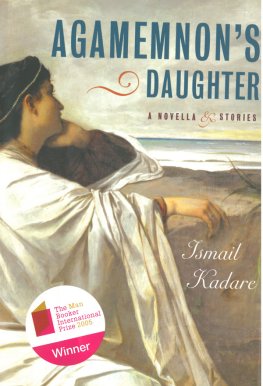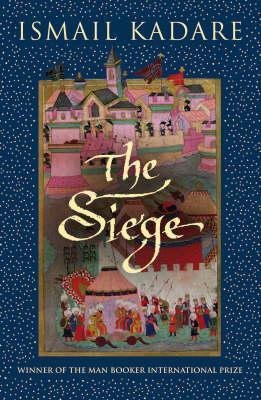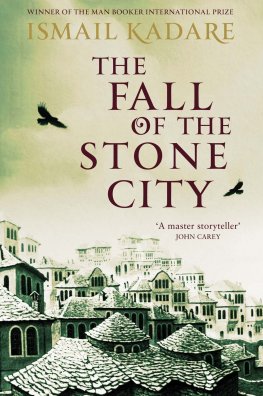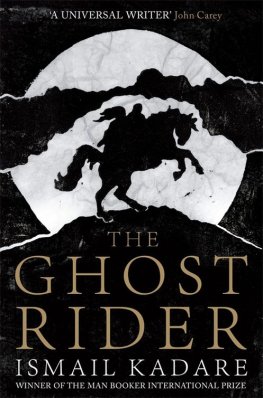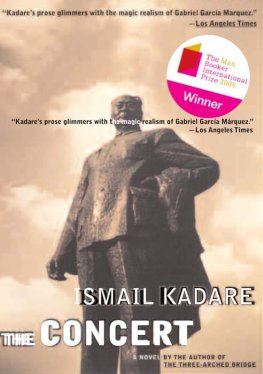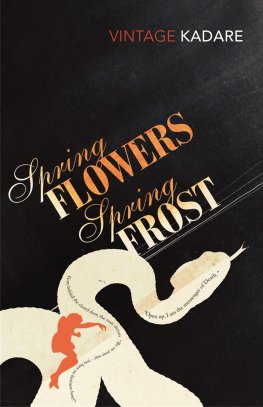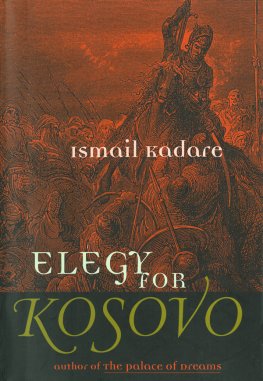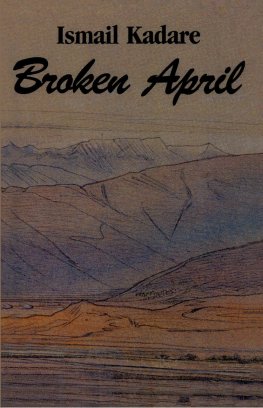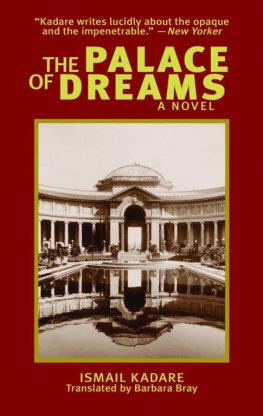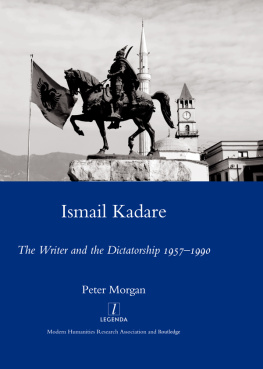Ismaíl Kadaré - Chronicle in Stone
Here you can read online Ismaíl Kadaré - Chronicle in Stone full text of the book (entire story) in english for free. Download pdf and epub, get meaning, cover and reviews about this ebook. genre: Prose. Description of the work, (preface) as well as reviews are available. Best literature library LitArk.com created for fans of good reading and offers a wide selection of genres:
Romance novel
Science fiction
Adventure
Detective
Science
History
Home and family
Prose
Art
Politics
Computer
Non-fiction
Religion
Business
Children
Humor
Choose a favorite category and find really read worthwhile books. Enjoy immersion in the world of imagination, feel the emotions of the characters or learn something new for yourself, make an fascinating discovery.

- Book:Chronicle in Stone
- Author:
- Genre:
- Rating:4 / 5
- Favourites:Add to favourites
- Your mark:
- 80
- 1
- 2
- 3
- 4
- 5
Chronicle in Stone: summary, description and annotation
We offer to read an annotation, description, summary or preface (depends on what the author of the book "Chronicle in Stone" wrote himself). If you haven't found the necessary information about the book — write in the comments, we will try to find it.
Chronicle in Stone — read online for free the complete book (whole text) full work
Below is the text of the book, divided by pages. System saving the place of the last page read, allows you to conveniently read the book "Chronicle in Stone" online for free, without having to search again every time where you left off. Put a bookmark, and you can go to the page where you finished reading at any time.
Font size:
Interval:
Bookmark:

Ismal Kadar
Chronicle in Stone
1971
Translated from the Albanian by Arshi Pipa
Edited and introduced by David Bellos
INTRODUCTION
Ismail Kadare was born in 1936 in Gjirokastr, an ancient, stone-built city in southern Albania clinging to the steep sides of a hill topped by a huge fortress, part of which has been used for centuries as a prison.
Close to the Greek border, Gjirokastr was badly mauled by several armies during the Second World War. In April 1939, Mussolini occupied Albania and annexed it to the short-lived Italian Empire. In 1940, the Italian Army stationed in Albania invaded Greece, but was repulsed and routed by the Greek Army supported by the RAF, which carried out heavy bombing raids over many parts of Albania between 28 October 1940 and 30 April 1941. In a counter-attack, the Italians retook the southern part of Albania: Gjirokastr then changed hands several times over. When Italy capitulated to the Allies in September 1943, the German Army, which had meanwhile invaded and occupied Yugoslavia and Greece, took over the whole of Albania, and occupied strategic points like Gjirokastr.
Chronicle in Stone narrates these traumatic events in the life of the city through the eyes of a dreamy, short-sighted, and highly imaginative child, whose thoughts and interests (in girls, murders, hermaphrodites and homosexuals) seem to make him a little older than Kadare actually was at the time. But the chronicle stops short of the wars real ending. The German Army collapsed and withdrew from the Balkans in the summer and autumn of 1944. With Yugoslavia, Albania was the only country in Europe to be liberated without the help of significant Allied forces. The Communist partisans led by Enver Hoxha entered Tirana in November 1944, and established a Peoples Republic which turned into Europes most long-lived, most bizarre and probably cruellest Stalinist regime. It crumbled only after the fall of Gorbachev and the failure of the Soviet generals putsch in August 1991. The omission from this memoir of a war-time childhood of the conventional narrative of national liberation by Communist partisans must be counted as a sly but perfectly visible act of literary resistance.
There were three separate national resistance movements in wartime Albania. The least significant was Legaliteti, a movement formed by supporters of the exiled King Zog (who ruled from 1924 until 1939), and which operated primarily in the northern parts of Albania. It barely figures in Kadares narrative, save as a rowdy gang referred to as Isa Toskas men. The second main non-Communist group was called Balli Kombtar (National Front), whose members were called Ballists. They figure more substantially in Chronicle in Stone, both as the perpetrators and as the victims of irrational violence. The third and by far the most effective resistance group were the partisans, organised and quickly dominated by the Albanian Communist Party. Isa and Javer, the two young men admired by the child narrator of this book, are members of this movement and share its political aspirations. Although Kadare does not deal with the liberation itself in this novel, his picture of a city divided between Ballists, Partisans and Isa Toskas men carries the clear implication that the struggle for freedom was something close to a civil war. Once again, this was significantly different from the official version of the birth of the socialist state.
Chronicle in Stone was not written all at once. It first emerged as an anecdote about The Big Plane, which was among Kadares earliest publications in prose, appearing in the literary review Nntori in 1962. (The childs fascination with aircraft is strangely similar to J. G. Ballards account of his own early years in Japanese captivity in Empire of the Sun.) Together with more anecdotes about his childhood and his early misapprehensions of the world and of words, Kadare reworked The Big Plane into a longer story of Gjirokastr, City of the South, which similarly appeared in a periodical in 1967. It was not until 1971 that an expanded, reworked and re-ordered novel entitled Chronicle in Stone appeared as a book. But that was only the beginning for Kadare is an obsessive rewriter of himself. Chronicle in Stone went through several editions in Albania, each incorporating larger or smaller developments, until it was finally brought into Kadares multi-volume Complete Works series published by Fayard in Paris in 1997, in strictly parallel French and Albanian versions. For this definitive text Kadare made many changes. Some dialogue passages were tightened up, others expanded; some historical and political passages were cut, and other passages whole pages of conversation between some of the stranger old ladies of the town, for example were added. But even this definitive version may not be quite the end of the story. In 2004, while spending a month as Writer in Residence at Bard College, New York, Kadare wrote an entirely new short story, A Climate of Lunacy, set in Gjirokastr during the authors childhood, and introducing more of the curious and entertaining characters in the family circle that we meet in Chronicle in Stone, written forty years before.
Chronicle in Stone, like most of Kadares fiction, was translated into French before appearing in other languages. For hazy editorial reasons that seem to have been lost, the French translation by Jusuf Vrioni was entitled Chronique de la ville de pierre, Chronicle of the City of Stone, and it is by that title that the book is still widely remembered in France. However, its real title is simply Chronicle in Stone (Kronik n gur in Albanian), and in Kadares Complete Works in French it has been retitled to conform, as Chronique de pierre. Like the monument built by Kheops in Kadares later parable, The Pyramid, the real message or mystery of Gjirokastr is not written on stone: it is stone.
One of the central characters in the life of Kadares child narrator is his maternal grandfather. In Albanian, the mothers father (the line of milk) is named and treated somewhat differently from the fathers father (the line of blood). The familiar term used by the child, babazoti, literally means father-lord, the second half of the word also serving to refer to God (just like the Lord in English). In this translation, I have for the most part translated babazoti by grandfather or grandpa, but left the original term here and there so as to communicate the flavour of a now vanished form of family life.
Babazoti lies on a divan all day reading books in Turkish, for he is old enough (in 1941-3) to have spent his youth and manhood as a citizen and official of the Ottoman Empire, which only relinquished its control of Albania in 1913. The old women who particularly fascinate the child are all the daughters, widows or wives of Albanian Muslim landowners, or of officials of the former empire, and it is to the Ottoman past that they owe the relative prosperity that allowed them to construct the large and mysterious houses that provide the child with such a rich source of imaginative life. Among them is a group of centenarian women, the old crones, and a fearsome group of somewhat less aged old ladies known as the mothers-in-law, called katenxhikas in the dialect of Gjirokastr. Ottoman influence is also responsible for the hashure (a kind of halva) and hot saleep (orchid-root tea) hawked on the streets and even in the citadel when it is used as an air-raid shelter.
For the society depicted in this novel, the words Greek, Christian and peasant are virtually interchangeable. Only a few words of Greek are known to the child, and this despite the fact that Greece itself is only a few miles from Gjirokastr. When the young revolutionaries Isa and Javer speak in a foreign tongue so as not to be understood by the little ones, the language they use is the Latin they learned in school. This is never stated explicitly in the novel because for Albanian readers of Kadares generation it goes without saying.
Next pageFont size:
Interval:
Bookmark:
Similar books «Chronicle in Stone»
Look at similar books to Chronicle in Stone. We have selected literature similar in name and meaning in the hope of providing readers with more options to find new, interesting, not yet read works.
Discussion, reviews of the book Chronicle in Stone and just readers' own opinions. Leave your comments, write what you think about the work, its meaning or the main characters. Specify what exactly you liked and what you didn't like, and why you think so.

